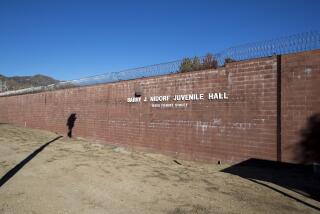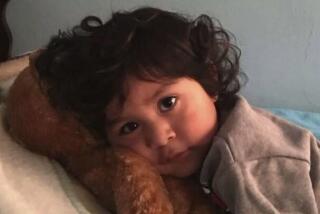State Juvenile Court Still Struggles to Find Balance
One hundred years ago, California became the seventh state to establish a separate court system for delinquent and dependent children.
This year, on the anniversary of the Juvenile Court, the system and its shortcomings continue to be scrutinized. Hundreds of attorneys, judges and social workers throughout the state gathered in Los Angeles earlier this month to celebrate the anniversary and discuss ways to make the court more effective.
Participants agreed that programs that work need to be identified and duplicated. Families need to become more involved, and overlapping issues of mental health, substance abuse and family violence need to be weighed. And professionals must continue to rehabilitate youths, and hold them accountable for their offenses.
The Juvenile Court is often overlooked until a shocking case occurs -- a child dies in foster care or a teenage criminal goes on a shooting rampage at a school, judges say.
“Every day in California, there are literally thousands of decisions made, critical junctures in the lives of our children,” said Superior Court Judge Leonard Edwards, who supervises the dependency court in Santa Clara County. “A child is adopted, a child is removed, a child is sent to the California Youth Authority.”
Contrary to public perception, a 30% drop in juvenile arrests has occurred in California over the last decade, according to the state Administrative Office of the Courts. Nevertheless, California’s numbers remain high. In 2002, there were nearly 230,000 juvenile arrests. And juveniles are being locked up in record numbers. California’s drop in juvenile crime is paralleled nationwide, experts said.
“There are always pockets of problems, but nationally [juvenile crime] is down,” said Howard Snyder, director of systems research at the National Center for Juvenile Justice. “We’re doing a pretty good job with our kids.”
The nation’s first Juvenile Court opened in Chicago in 1899 to provide children with legal protections and to ensure that they were not housed in adult prisons. California opened its court in Los Angeles in 1903 when then-Gov. George Pardee signed legislation that created a court with exclusive jurisdiction over proceedings for abused, neglected and delinquent children.
Juvenile Court professionals have struggled with competing demands since the beginning, such as the need to reform and punish at the same time.
Another is the pull between treating foster children who commit offenses as dependents or as delinquents. The Judicial Council of California proposed legislation this month that would give counties joint jurisdiction over children who are dependents of the court and who have committed offenses.
So if a 14-year-old in foster care is picked up for shoplifting, for example, the youth would not have to be removed from the dependency system.
Advocates remain concerned that people younger than 18 may be executed in many states, and that about 200,000 juveniles nationwide are sent each year to the adult system. Three years ago, California voters passed Proposition 21, which was designed to make it easier for juveniles to be tried as adults.
The initiative gave prosecutors, instead of judges, the authority to decide whether certain teens should be tried as adults.
“The pendulum of the past 20 years has swung too far toward the punishment side,” said Judge Edwards. “The Juvenile Court is based upon the fact that kids are different from the adults. We think that we have to have the pendulum swing back.”
Attorneys at the Sacramento-based nonprofit Criminal Justice Legal Foundation, however, disagreed. They said Proposition 21 was a useful reform that has made the community safer.
“If anything, the pendulum has been righted to give more discretion to the district attorney,” said attorney Charles Hobson.
Hobson said the change has allowed prosecutors to treat crimes the same, whether committed by a juvenile or an adult.
“Some juveniles are extraordinarily dangerous by committing particularly bad crimes,” he said. “The juvenile system has a limited ability to punish and incapacitate those juvenile offenders.”
Resources are also stretched thin, said Diane Nunn, director of the state’s Center for Families, Children and the Courts. As a result, social workers, probation officers and attorneys must handle overwhelming caseloads while ensuring that foster homes and juvenile justice facilities are safe. Some said the limited resources result in less money and attention for prevention programs.
Among the biggest challenges facing the courts is working with agencies throughout the state to address problems in a comprehensive way. The courts don’t operate in a vacuum, Nunn said, and the youths often need drug treatment, mental-health care and educational services. Their families also need to be connected to family violence prevention or other social service organizations.
As a result, the court must rely on other agencies to provide services.
“The court can’t do it on its own,” Nunn said. “That was the challenge at the beginning and that’s the challenge now.”
More to Read
Sign up for Essential California
The most important California stories and recommendations in your inbox every morning.
You may occasionally receive promotional content from the Los Angeles Times.










